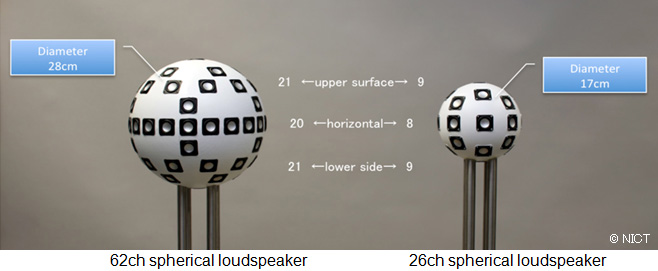NICT has been conducting researches and developments in ultra-realistic communication technology, which aims to enable individuals separated in time or space to feel like they are sharing the same sensations. Large imaging systems such as movies use conventional stereo or 5.1 channel surround sound methods, which are capable of representing a sound source in a single direction. However, since there are imaging systems capable of representing three dimensions spatially, the orientation of a projected object can be represented so that different images can be viewed depending on the viewing position. Therefore, a major topic of research has been to create a method of reproducing a sound source in all directions.
Home > Press Release > NICT Introduces the World’s First 62-Channel 3D Sound System
- Acoustically Reproduces the Sensation of Musician Motion During a Performance -
The National Institute of Information and Communications Technology (NICT) has developed the world’s first sound system capable of representing a moving sound source such as an instrument or singer in three dimensions. Conventional sound systems such as stereo or 5.1 channel systems can represent sound source motion, they have major drawbacks as sound systems for 3D imaging since the sound source can be reproduced in only one direction or the sound source orientation and motion cannot be reproduced at all.
The new NICT system is able to create a 3D representation including sound source orientation and motion by emitting acoustic signals from 62 independently driven channels in different directions to compose the sound source in space. The resultant acoustic representation can be perceived more easily since the resolution is 2.5 times better horizontally and 1.5 times better vertically than with the conventional device.
NICT’s new 3D sound system creates composition areas by subdividing the equator of a sphere into 20 parts and dividing both the upper and lower hemispheres in half so that sound can be emitted in 62 directions. This improves the precision with which the sound source orientation can be represented, making it easier for the listener to perceive, for example, the direction in which a singer is facing or the movement of a violin player during a performance. Also, by increasing the number of speaker units and the enclosure capacity and increasing the composition sound density. In addition, the types of reproducible sound sources are also increased. This enables sound to be realized with a better sense of presence and realism than had been achieved conventionally.
The advanced technology of our new 3D sound system will further ultra-realistic communication and contribute to the development of the ultimate 3D TV in the future. We intend to enlarge the frequency band that can be accurately reproduced in this system. Since the current 3D sound system reproduces sound from only one source, we intend to extend our research and development efforts towards techniques that enable multiple sound sources to be reproduced concurrently.
Supplementary Information

This new globular speaker with 62-channel in the front plays solo part while a general ones in the rear do background performance of music. It is possible to perceive the difference between a stereophony and usual acoustic rendering.

Technical Contact
Dr. Michiaki Katsumoto
3D Spatial Image & Sound Group
Universal Media Research Center
E-mail: 

















TEL:+81-42-327-6425
Media Contact
Ms. Sachiko HIROTA
Public Relations Office
Strategic Planning Department
E-mail: 



















TEL:+81-42-327-6923






